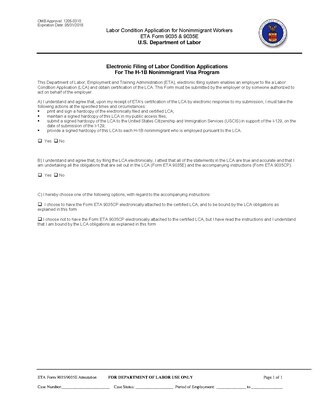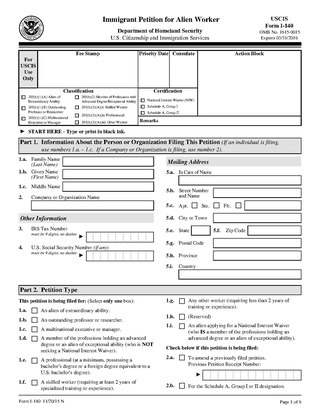The H-1B is a visa in the United States under the Immigration and Nationality Act, section 101(a)(15)(H), that allows U.S. employers to employ foreign workers in specialty occupations. A specialty occupation requires the application of specialized knowledge and a bachelor's degree or the equivalent of work experience. The duration of stay is three years, extendable to six years, after which the visa holder can reapply. Laws limit the number of H-1B visas that are issued each year. There exist congressionally mandated caps limiting the number of H-1B visas that can be issued each fiscal year, which is 65,000 visas, and an additional 20,000 set aside for those graduating with master’s degrees or higher from a U.S. college or university. An employer must sponsor individuals for the visa. USCIS estimates there are 583,420 foreign nationals on H-1B visas as of September 30, 2019. The number of issued H-1B visas have quadrupled since the first year these visas were issued in 1991. There were 206,002 initial and continuing H-1B visas issued in 2022.
An L-1 visa is a visa document used to enter the United States for the purpose of work in L-1 status. It is a non-immigrant visa, and is valid for a relatively short amount of time, from three months to five years, based on a reciprocity schedule. With extensions, the maximum stay is seven years.
TN status is a special non-immigrant classification of foreign nationals in the United States, which offers expedited work authorization to a citizen of Canada or a national of Mexico. It was created as a result of provisions of the North American Free Trade Agreement that mandated simplified entry and employment permission for certain professionals from each of the three NAFTA member states in the other member states. The provisions of NAFTA relevant to TN status were then carried over almost verbatim to the United States–Mexico–Canada Agreement that replaced NAFTA in 2020.
A guest worker program allows foreign workers to temporarily reside and work in a host country until a next round of workers is readily available to switch. Guest workers typically perform low or semi-skilled agricultural, industrial, or domestic labor in countries with workforce shortages, and they return home once their contract has expired.
An H-4 visa is a United States visa issued to dependent family members of H-1B, H-1B1, H-2A, H-2B, and H-3 visa holders to allow them to travel to the United States to accompany or reunite with the principal visa holder. A dependent family member is a spouse or unmarried child under the age of 21. If a dependent of an H-1B, H-1B1, H-2A, H-2B, or H-3 worker is already in the United States, they can apply for H-4 immigration status by filing Form I-539 for change of status with United States Citizenship and Immigration Services (USCIS).

A Form I-766 employment authorization document or EAD card, known popularly as a work permit, is a document issued by the United States Citizenship and Immigration Services (USCIS) that provides temporary employment authorization to noncitizens in the United States.
The H-2B visa nonimmigrant program permits employers to hire foreign workers to come temporarily to the United States and perform temporary nonagricultural services or labor on a one-time, seasonal, peakload or intermittent basis.
An H-3 visa is a visa issued by the U.S. Citizenship and Immigration Services (USCIS) to trainees or special education exchange visitors, who intend to perform their job outside the United States. Trainees' spouses and children who are under the age of 21 may accompany them to, but may not work in, the United States.

The Border Security, Economic Opportunity, and Immigration Modernization Act of 2013 was a proposed immigration reform bill introduced by Sen. Charles Schumer (D-NY) in the United States Senate. The bill was co-sponsored by the other seven members of the "Gang of Eight", a bipartisan group of U.S. Senators who wrote and negotiated the bill. It was introduced in the Senate on April 16, 2013, during the 113th United States Congress.

The Labor Condition Application (LCA) is an application filed by prospective employers on behalf of workers applying for work authorization for the non-immigrant statuses H-1B, H-1B1 and E-3. The application is submitted to and needs to be approved by the United States Department of Labor Employment and Training Administration (DOLETA)'s Office of Foreign Labor Certification (OFLC). The form used to submit the application is ETA Form 9035.
The American Competitiveness and Workforce Improvement Act (ACWIA) was an act passed by the government of the United States on October 21, 1998, pertaining to high-skilled immigration to the United States, particularly immigration through the H-1B visa, and helping improving the capabilities of the domestic workforce in the United States to reduce the need for foreign labor.
The H-1B1 visa is a variant of the H-1B visa in the United States for nationals of Singapore and Chile. The version for Singapore is called the H-1B1-Singapore and the version for Chile is called the H-1B1-Chile. These categories were introduced with the Singapore–United States Free Trade Agreement and Chile–United States Free Trade Agreement respectively, both of which were ratified in 2003 by the 108th United States Congress and became active on January 1, 2004. The visas are also called FTA visas because they were provided for through Free Trade Agreements (FTAs).
Form I-129, Petition for a Nonimmigrant Worker is a form submitted to the United States Citizenship and Immigration Services used by employers or prospective employers to obtain a worker on a nonimmigrant visa status. Form I-129 is used to either file for a new status or a change of status, such as new, continuing or changed employer or title; or an amendment to the original application. Approval of the form makes the worker eligible to start or continue working at the job if already in the United States. If the worker is not already in the United States, an approved Form I-129 may be used to submit a visa application associated with that status. The form is 36 pages long and the instructions for the form are 29 pages long. It is one of the many USCIS immigration forms.
The United States Citizenship and Immigration Services (USCIS) issues a number of forms for people to submit to them relating to immigrant and non-immigrant visa statuses. These forms begin with the letter "I". None of the forms directly grants a United States visa, but approval of these forms may provide authorization for staying or extending one's stay in the United States as well as authorization for work. Some United States visas require an associated approved USCIS immigration form to be submitted as part of the application.
The Legal Immigration Family Equity Act of 2000, also known as the LIFE Act and as the Legal Immigration and Family Equity Act, along with its Amendments, made some changes to laws surrounding immigration for family members of United States citizens and Lawful Permanent Residents, as well as people eligible for employment-based immigrant visas, in the direction of making it easier for family members and immigrant workers to move to and adjust status within the United States. It was passed on December 21, 2000, as title XI of Pub. L.Tooltip Public Law 106–553 (text)(PDF).

Form I-140, Immigrant Petition for Alien Worker is a form submitted to the United States Citizenship and Immigration Service (USCIS) by a prospective employer to petition an alien to work in the US on a permanent basis. This is done in the case when the worker is deemed extraordinary in some sense or when qualified workers do not exist in the US. The employer who files is called the petitioner, and the alien employee is called the beneficiary; these two can coincide in the case of a self-petitioner. The form is 6 pages long with a separate 10-page instructions document as of 2016. It is one of the USCIS immigration forms.
The term H-1B-dependent employer is used by the United States Department of Labor to describe an employer who meets a particular threshold in terms of the fraction of the workforce comprising workers in H-1B status. An employer classified as H-1B-dependent needs to include additional attestations in the Labor Condition Application used for the petition of any H-1B beneficiary being offered an annual compensation of less than $60,000 and without a master's degree. The notion was introduced by the American Competitiveness and Workforce Improvement Act (ACWIA) passed in 1998 and operationalized through the United States Department of Labor's Interim Final H-1B Rule of December 20, 2000. The regulation is found in 20 CFR 655.736 in the Code of Federal Regulations.
In the United States, the most common visa used for short-term trips is the B visa. This is a combination of the B-1 visa and the B-2 visa. People on B visas are generally not allowed to engage in productive work or study activities. However, in some cases, B visas can be issued that allow people to engage in some types of productive work and learning activity, in lieu of another visa. The three visa categories, for which a B visa could be issued instead, are the H-1B visa, H-3 visa, and J-1 visa. The U.S. Department of State recommends that consular officers clearly annotate such B visas to make the scope of the visa clear to the applicant and the U.S. Customs and Border Protection officer at the port of entry.
The H-1C visa was a visa that was previously available to foreign nationals seeking temporary employment in the United States. These visas were made available to foreign nurses coming into the United States to perform services as a registered nurse in areas with a shortage of health professionals as determined by the Department of Labor. The creation of this visa was prompted by a nursing shortage.
The H-1A visa was a visa that was previously available to foreign nationals seeking temporary employment in the United States. These visas were made available to foreign nurses coming into the United States to perform services as a registered nurse in areas with a shortage of health professionals as determined by the Department of Labor. The creation of this visa was prompted by a nursing shortage.





